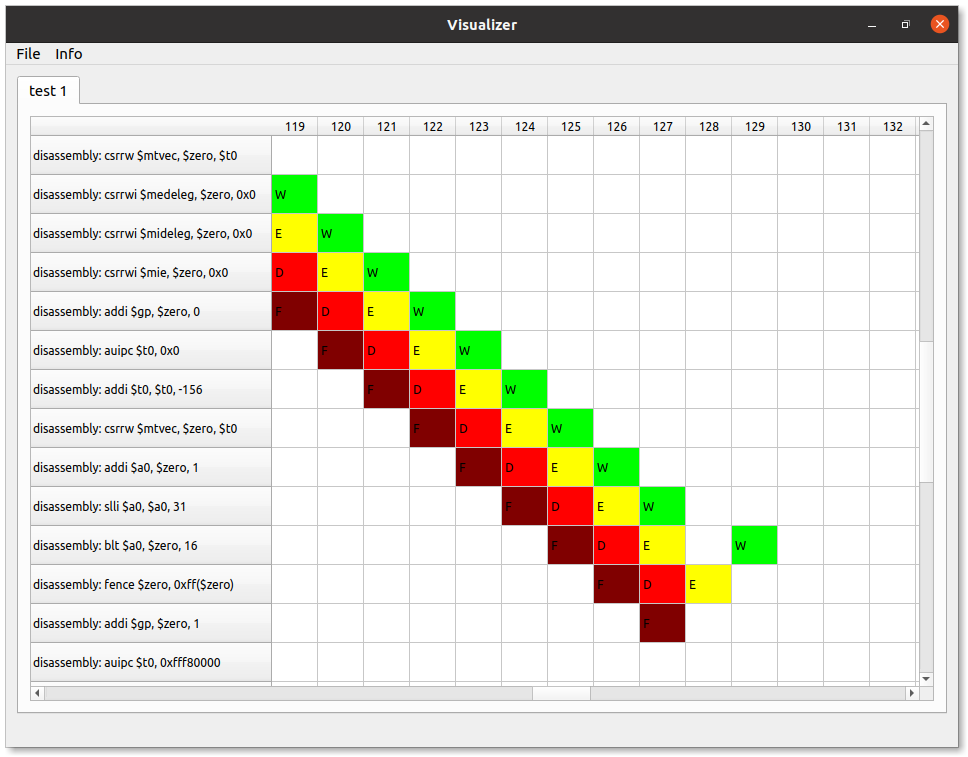MIPT-V / MIPT-MIPS is a pre-silicon simulator of MIPS and RISC-V CPU. It measures performance of program running on CPU, thus taking best features of RTL and common functional simulation:
- Precision. We provide cycle-accurate models of branch prediction unit, pipeline, and other hardware internals.
- Customization. Cache size, branch prediction algorithms, and other parameters can be easily changed even to unfeasible modes.
- Simplicity. Our source files are much more readable than RTL and independent on SDK and synthesis flow.
- Speed. 2 MHz simulation frequency on Cascade Lake.
- Scalability. Modularized structure allows integration of more microarchitecture configurations.
Simulator can be used for different purposes:
- Performance control of software optimizations: you may check what and why happened to IPC.
- Pathfinding of hardware optimizations: you may easily integrate some nice feature to CPU model.
- Comparison of hardware solutions from different vendors.
- Performance control of developed or produced hardware.
- Education: simulator is a nice experimental frog to study CPU internals and software development process.
Key system-level features:
Key microarchitecture features:
- Configurable branch prediction unit with several prediction algorithms
- Configurable instruction cache
- Interstage data bypassing
More details about internals are available on Wiki.
For questions, use our Discussions page.
We use C++20 features and Boost 1.71. Thus, you have to use compilers of these versions or newer:
- GCC 11
- Clang 13.0.0
- Apple LLVM Version 13.1.6
- MS Visual Studio 2019 16.8
Install Boost before building the project.
To work with RISC-V traces, you need to install RISC-V toolchain. Please follow the official instruction.
To work with MIPS traces, you need to install MIPS binutils. Please follow our manual if you are using Linux, OS X, or Windows.
Our build system is CMake. You should install CMake 3.13.5 or higher. Check our Wiki page to get more details about CMake. Users of IDE (Visual Studio, Eclipse, CodeBlocks etc.) may generate project files with CMake as well.
To generate RISC-V opcodes, CMake uses Python. python3 interpreter should be available in your environment.
-b <filename>— provide path to ELF binary file to execute.-n <number>— number of instructions to run. If omitted, simulation continues until halting system call or jump tonullis executed.
-I— modeled ISA. Default version ismars.mips32,mips64— state-of-the-art MIPSriscv32,riscv64,riscv128— RISC-V with all instructionsspim,spim64— simplified MIPS without delayed branchesmipsI,mipsII,mipsIII,mipsIV— legacy MIPS versions
-f— enables functional simulation only--mars— enables MARS-compatible mode of system calls
-l— enables per-module output, for instance:-l fetch,decode— prints only fetch and decode stages-l cpu— prints all stages-l cpu,!mem— print all except mem stage
-d— enables output of functional simulator--tdump— enables module topology dump into topology.json
--bp-mode— prediction mode. Check supported modes in manual--bp-lru— prediction replacement policy: LRU, pseudo-LRU, or infinite--bp-size— branch prediction cache size (amount of tracked branch instructions)--bp-ways— # of ways in branch prediction cache
--icache-type— instruction cache type: LRU, pseudo-LRU, always-hit, or infinite--icache-size— instruction cache size in bytes--icache-ways— # of ways in instruction cache--icache-line-size— line size of instruction cache
--long-alu-latency- number of execution stages required for long arithmetic instructions to be complete
- Check that your environment meets all the requirements above.
- Clone repository with submodules:
git clone --recursive https://github.com/MIPT-ILab/mipt-mips.git
To build simulator faster, we recommend to install Ninja.
- Create a new build directory somewhere, then cd into it:
mkdir /path/to/your/build/directory - Go to the build directory:
cd /path/to/your/build/directory - Run
cmake /path/to/mipt-mips/simulator -G "Ninja"to configure CMake - Run
ninjato get themipt-mipsbinary file - If you changed some source code files, just type
ninjato rebuild project
- Now you can run simulation:
./mipt-mips -b /path/to/binary - See more command line options in the paragraph below
- To run all unit tests, call
ninja unit-tests && ctest --verbose -C Releasefrom your build directory.
This project is a part of ILab activity at Moscow Institute of Physics and Technology (MIPT).
The main goal of the project is to teach the students the computer architecture through development of a microprocessor implementing the RISC-V and MIPS instruction set in both functional and performance simulators.
Yes, if you attend lectures on Computer Architecture. See our contributing.md file for details.






